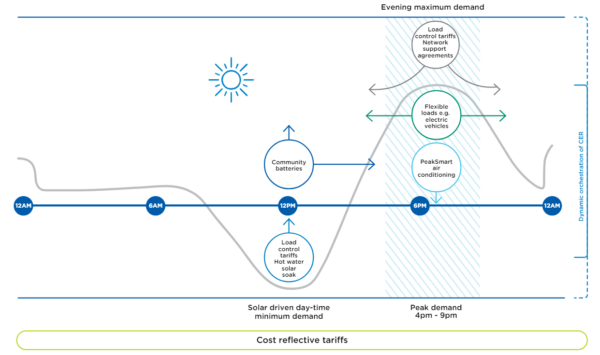Modeling shows that shifting just a third of Australia’s commercial and institutional electricity consumption to the middle of the day, which coincides with peak solar supply, would create almost 12 GW of new peak capacity in the national electricity market.
The researchers behind the new “Buildings like batteriesOne article claims that shifting Australia’s cargo to the middle of the day would save AUD 1.7 billion ($1.1 billion) per year. They claim it would also add additional peaking capacity, equivalent to 52% of Australia’s existing coal-fired generation fleet, and significantly reduce greenhouse gas emissions from electricity in the country.
“Fortunately, it is relatively easy for everyone except the owners of the coal-fired power plants to shift much of the electricity demand from late afternoon to the middle of the day,” he said. “Our research shows that large commercial buildings are particularly good at shifting their daily electricity demands so they can better take advantage of the cheap, clean energy that is so abundant in the middle of the day.”
The paper cites an example of a large office tower in Sydney, where building managers were told that electricity demand was likely to be extremely high on a hot summer day in 2019. In response, the building’s internal temperature was reduced by 1. degree from 8:30 a.m. to 2 p.m. The figures show that the building used more electricity earlier in the day, reducing demand by 200 kW compared to forecasts from 2 p.m. to 6 p.m.
“The building effectively functioned as a battery with a capacity of at least 800 kWh,” the report said. “We estimate that this resulted in savings of AUD 111 and 221 kg of CO2e in emissions in just one day in that one building. A battery that size would cost approximately AUD 500,000. Extrapolating for the whole of Australia, if 33% of late afternoon building energy use in summer were shifted to the middle of the day, that would create new peak energy market capacity of almost 12 GW.”
The report said that if a government program would do that develop the demand side launched in the National Electricity Market this year, it could deliver load shifting in 30% of Australian institutional-grade office buildings by 2025, rising to 90% by 2027.
The researchers said such a program, which would deliver about 2.6 GW of flexible capacity by the end of 2026, could be achieved through relatively minor changes in building management practices, such as cooling large office buildings earlier in the day and then allowing of their temperature to rise back to normal levels during the afternoon.
The researchers warned that policy and regulatory changes would be needed as current efficiency rating systems hold back the adoption of new technologies by failing to recognize the financial, emissions and network stabilizing potential of smart, network-interactive buildings.
pv magazine
The May edition of pv magazine, out Friday, examines the global polysilicon oversupply and tightening financing in China, looks at the fast-growing U.S. solar glass industry, updates readers on the latest advances in perovskite, and considers how PV might be developed as the bullets fly . All this plus features from Turkey, Italy, Azerbaijan and more.
Craig Roussac, CEO of Buildings Alive, said the solutions to this problem already exist, and the country just needs to start using them.
“If we don’t realize the potential of smart, grid-interactive buildings, Australians will pay the price through higher network costs, more expensive electricity and increased carbon pollution,” he said. “Australia has had leading building efficiency assessment systems in the past, but these have not evolved. Most buildings can double their energy needs at times of the day when there is sufficient energy, and halve them when networks are limited. This is a tremendous service they can provide.”

The report recommends a range of policy measures to support load shifting and demand response, including commissioning NABERS to develop and implement an updated building efficiency rating system that recognizes the potential of these measures.
The researchers also said governments should implement demand flexibility in their own buildings and work with energy innovators and the real estate sector to accelerate the development of load shifting and broader demand response. They also said federal government agencies such as ARENA and the CEFC could assist by soliciting related project proposals and through concessional financing.
The report states that it would be necessary for the electricity market operator, supervisors and regulators to ensure that load shifting can compete in the wholesale demand response market.
This content is copyrighted and may not be reused. If you would like to collaborate with us and reuse some of our content, please contact: editors@pv-magazine.com.


